Dynamic Response Analysis and Positioning Performance Evaluation of an Arctic Floating Platform Based on the Mooring-Assisted Dynamic Positioning System
Abstract
1. Introduction
2. Theoretical Method
2.1. Calculation Method of Wave Load
- —Velocity potential of the incident wave
- —Radiation velocity potential
- —Diffraction velocity potential
- t—Time
- —Coordinate of any point in the flow field
- A—Wave amplitude
- k—Wave number
- —Wave direction angle
- z—Coordinate of water quality point
- H—Water depth
- —Wave frequency
- —Gravitational acceleration
2.2. Calculation Method of Ice Load
2.2.1. Finite Element Method Based on Fluid-Structure Interaction
2.2.2. Discrete Element Method
- —Normal force between particles
- —Normal moment between particles
- —Tangential force between particles
- —Tangential moment between particles
- —Radius of the bonding disk
- —Cross-sectional area of the bonding disk
- —Moment of inertia of the bonding disk
- —Polar moment of inertia of the bonding disk
- —Normal bonding strength
- —Tangential bonding strength
2.3. Method for Load Analysis of Mooring Systems
- —External force per unit length
- —Mass per unit length
- —Moment applied per unit length
2.4. The Control Method of the Dynamic Positioning System
3. Numerical Model and Validation
3.1. Model Information and Operating Condition Introduction
3.2. Hydrodynamic Performance Prediction and Mesh Convergence Verification
3.3. Comparison of Ice Load Simulation Methods
4. Analysis of the Results
4.1. Mooring Lines Tension under Different Positioning Modes
4.2. Platform Motion under Different Positioning Modes
4.2.1. Surge, Sway and Yaw Motion of the Platform under Different Environmental Loads
4.2.2. Motion Trajectories of the Platform under Different Positioning Modes
5. Conclusions
- Compared with the mooring system, the mooring-assisted dynamic positioning system can effectively reduce the tension of the mooring lines, but the effect is not significant enough under the condition of level ice. In the composite positioning system, the mooring system plays a greater role than the dynamic positioning system, which is the main part of providing the recovery force for the platform. Under the same mooring arrangement, the change in the number and position of thrusters will not have a significant impact on the average tension of the mooring system.
- Compared with a mooring system, a mooring-assisted dynamic positioning system can reduce platform deviation. The influence of a dynamic positioning system on sway and yaw motion under different environmental loads should be considered comprehensively in the design. Mooring lines or thrusters should be arranged in the main direction of the platform structure to avoid excessive surge motion. In the design scheme of this paper, eight thrusters and four thrusters (Pattern 2) have a better positioning effect on the platform. The arrangement of thrusters in the direction of the non-mooring system is more conducive to the stability of the platform.
- Compared with wave condition, ice condition has a higher correlation with different positioning methods. Ice loads can lead to greater differences in platform motion responses. The tension of the mooring system changes more considerably under level ice. The maximum surge, sway and yaw motion of the platform under different design schemes also fluctuate the most in level ice condition. From the time-domain analysis, it can be observed that the period and amplitude of the platform’s reciprocating motion under the broken ice floes are more obvious than that under the wave loads.
Author Contributions
Funding
Data Availability Statement
Acknowledgments
Conflicts of Interest
References
- Berkman, P.A.; Young, O.R. Governance and Environmental Change in the Arctic Ocean. Science 2009, 324, 339–340. [Google Scholar] [CrossRef]
- Idris, A.J.; Montasir, O.A.; Anurag, Y.; Zafarullah, N.; Akihiko, N. Optimisation of mooring line parameters for offshore floating structures: A review paper. Ocean. Eng. 2022, 247, 110644. [Google Scholar]
- Zhang, H.; Wang, H.; Cai, X.; Xie, J.; Wang, Y.; Zhang, N. Novel method for designing and optimising the floating platforms of offshore wind turbines. Ocean. Eng. 2022, 266 Pt 2, 112781. [Google Scholar] [CrossRef]
- Henderson, J.; Loe, J.S. The Prospects and Challenges for Arctic Oil Development. Oil Gas Energy Law J. 2016, 14. [Google Scholar]
- Amaechi, C.V.; Reda, A.; Butler, H.O.; Ja’e, I.A.; An, C. Review on Fixed and Floating Offshore Structures. Part I: Types of Platforms with Some Applications. J. Mar. Sci. Eng. 2022, 10, 1074. [Google Scholar] [CrossRef]
- Wright, B. Evaluation of Full Scale Data for Moored Vessel Stationkeeping in Pack Ice; PERD/CHC Report 26–200; National Research Council Canada: Ottawa, ON, Canada, 1999. [Google Scholar]
- Zhou, L.; Su, B.; Riska, K.; Moan, T. Numerical simulation of moored structure station keeping in level ice. Cold Reg. Sci. Technol. 2012, 71, 54–66. [Google Scholar] [CrossRef]
- Kong, S.; Ji, S.; Ji, S.; Wang, Y.Y.; Gang, X.H. Numerical analysis of ice load on floating platform in polar region based on high-performance discrete element method. Chin. J. Ship Res. 2021, 16, 64–70. [Google Scholar]
- Jang, H.; Kim, M. Kulluk-shaped arctic floating platform interacting with drifting level ice by discrete element method. Ocean Eng. 2021, 236, 109479. [Google Scholar] [CrossRef]
- Zhang, A.; Chuang, Z.; Liu, S.; Zhou, L.; Qu, Y.; Lu, Y. Dynamic performance optimization of an arctic semi-submersible production system. Ocean Eng. 2022, 244, 110353. [Google Scholar] [CrossRef]
- Sargent, J.; Morgan, M. Augmentation of a Mooring System Through Dynamic Positioning. In Proceedings of the Offshore Technology Conference, Houston, TX, USA, 5–7 May 1974. [Google Scholar]
- Strand, J.; Sørensen, A.; Fossen, T. Modeling and control of thruster assisted position mooring systems for ships. IFAC Proc. Vol. 1997, 19, 61–76. [Google Scholar]
- Aamo, O.; Fossen, T. Controlling line tension in thruster assisted mooring system. In Proceedings of the 1999 IEEE International Conference on Control Applications, Kohala Coast, HI, USA, 22–27 August 1999; pp. 13–17. [Google Scholar]
- Fang, S.; Blanke, M.; Leira, B.J. Optimal set-point chasing of position moored vessel. In Proceedings of the ASME 2010, 29th International Conference on Ocean, Offshore and Arctic Engineering, Shanghai, China, 6–11 June 2010; Volume 4, pp. 479–486. [Google Scholar]
- Wichers, J.; Dijk, R.V. Benefits of using assisted DP for Deepwater Mooring Systems. In Proceedings of the Offshore Technology Conference, Houston, TX, USA, 3–6 May 1999. [Google Scholar]
- Faltinsen, O.M. Sea Loads on Ships and Offshore Structures; Cambridge University Press: Cambridge, UK, 1990. [Google Scholar]
- Maruo, H. The drift of a body floating on waves. J. Ship Res. 1960, 4, 1–10. [Google Scholar]
- Pinkster, J.A.; van Oortmerssen, G. Computation of the first and second-order wave forces on oscillating bodies in regular waves. In Proceedings of the 2nd International Conference on Numerical Ship Hydrodynamics; University of California: Berkeley, CA, USA, 1977; pp. 136–159. [Google Scholar]
- Hallquist, J.O. LS-DYNA. Theoretical Manual; Livermore Software Technology Corporation: Livermore, CA, USA, 2006. [Google Scholar]
- Shen, H.H.; Hibler, W.D.; Lepparanta, M. On applying granular flow theory to a deforming broken ice field. Acta Mech. 1986, 63, 143–160. [Google Scholar] [CrossRef]
- Campbell, C.S. Stress-controlled elastic granular shear flows. J. Fluid Mech. 2005, 539, 273–297. [Google Scholar] [CrossRef]
- Potyondy, D.O.; Cundall, P.A. A bonded-particle model for rock. Int. J. Rock Mech. Min. Sci. 2004, 41, 1329–1364. [Google Scholar] [CrossRef]
- Mollon, G.; Zhao, J. Fourier–Voronoi-based generation of realistic samples for discrete modelling of granular materials. Granul. Matter. 2012, 14, 621–638. [Google Scholar] [CrossRef]
- Pangalila, F.V.; Martin, J.P. A Method of Estimating Line Tensions and Motions of a Semi-submersible Based on Empirical Data and Model Basis Results. In Proceedings of the Offshore Technology Conference, Houston, TX, USA, 17–20 May 1969; Volume 2, pp. 90–96. [Google Scholar]
- Igor, T.; Oleg, E.; Walter, P.; Barbaros, C. Numerical Modeling of Nonlinear Elastic Components of Mooing Systems. IEEE J. Ocean. Eng. 2005, 30, 37–46. [Google Scholar]
- Minorsky, N. Directional stability of automatically steered bodies. J. ASNE. 1922, 42, 280–309. [Google Scholar] [CrossRef]
- ISO 19906; Petroleum and Natural Gas Industries-Arctic Offshore Structures. International Organization for Standardization: Geneva, Switzerland, 2019.
- DNV. Sesam User Manual Sesam Manager; DNV: Høvik, Norway, 2018. [Google Scholar]
- Zhang, A.; Chuang, Z.; Liu, S.; Chang, X.; Hou, L.; He, Z.; Liu, S. Research on Mooring System Design for Kulluk Platform in Arctic Region. Water. 2022, 14, 1762. [Google Scholar] [CrossRef]
- Ye, L.; Wang, C.; Chang, X.; Zhang, H. Propeller-ice contact modeling with peridynamics. Ocean. Eng. 2017, 139, 54–64. [Google Scholar] [CrossRef]
- Wang, C.; Xiong, W.; Chang, X.; Ye, L.; Li, X. Analysis of variable working conditions for propeller-ice interaction. Ocean. Eng. 2018, 156, 277–293. [Google Scholar] [CrossRef]
- Xie, C.; Zhou, L.; Ding, S.; Liu, R.; Zheng, S. Experimental and numerical investigation on self-propulsion performance of polar merchant ship in brash ice channel. Ocean. Eng. 2023, 269, 113424. [Google Scholar] [CrossRef]
- Sun, Q.; Zhang, M.; Zhou, L.; Garme, K.; Burman, M. A machine learning-based method for prediction of ship performance in ice: Part I. ice resistance. Mar. Struct. 2022, 83, 103181. [Google Scholar] [CrossRef]
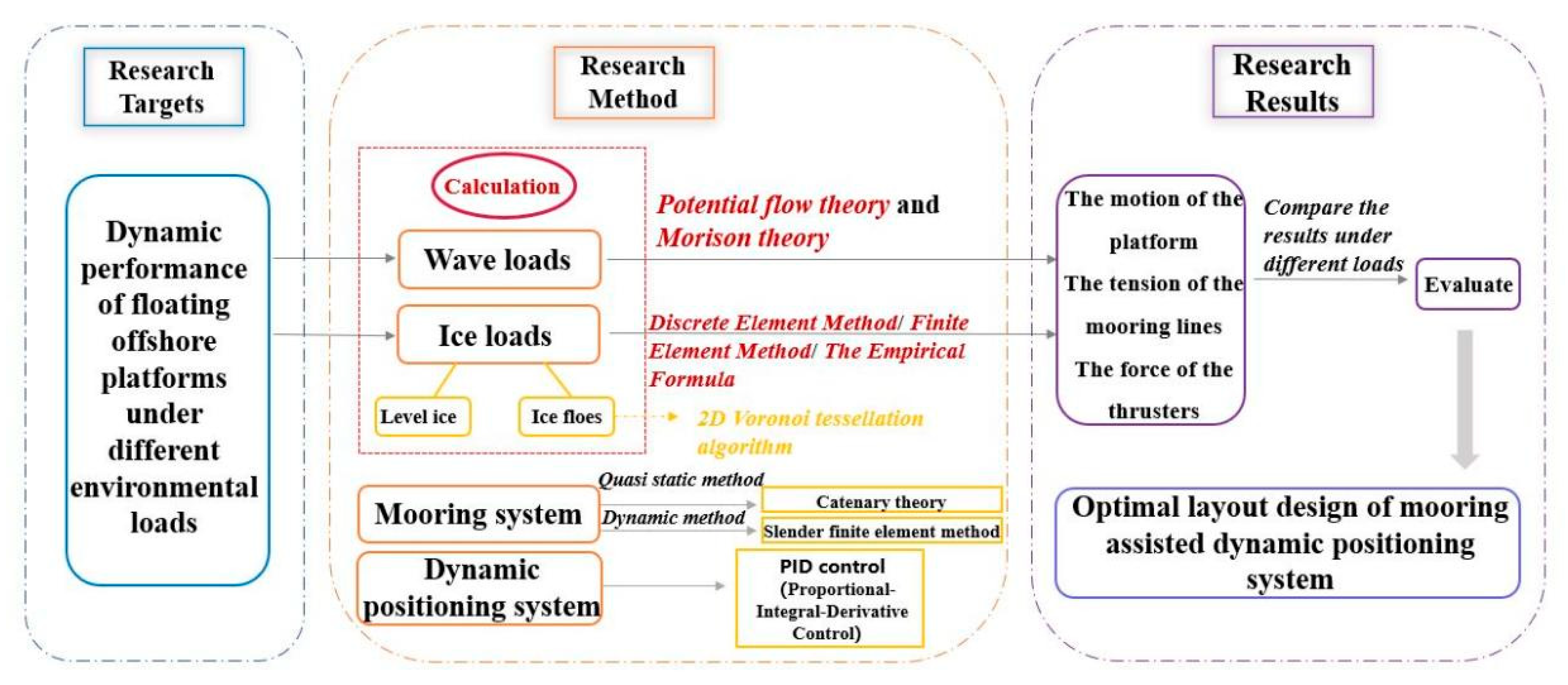

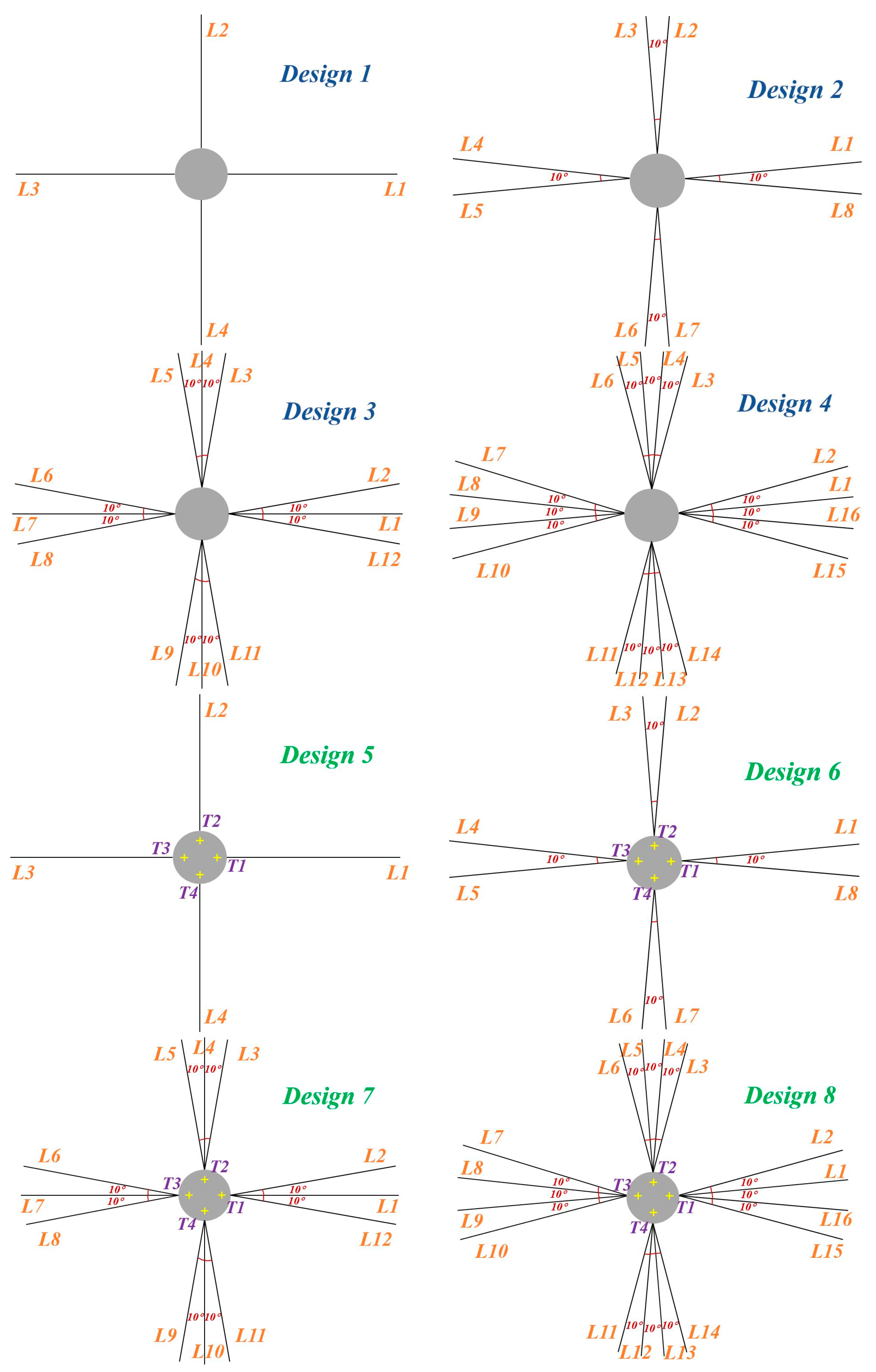
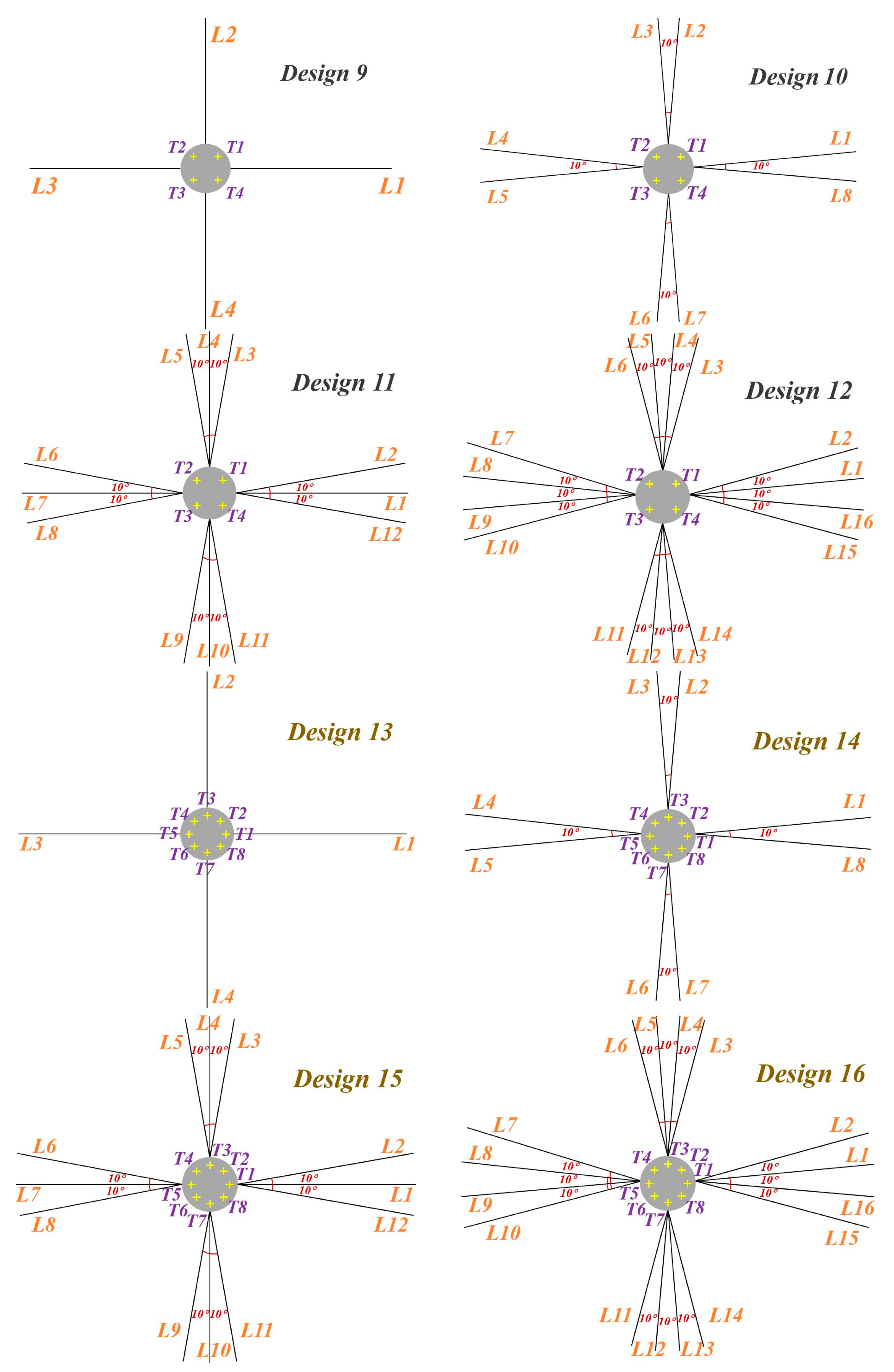

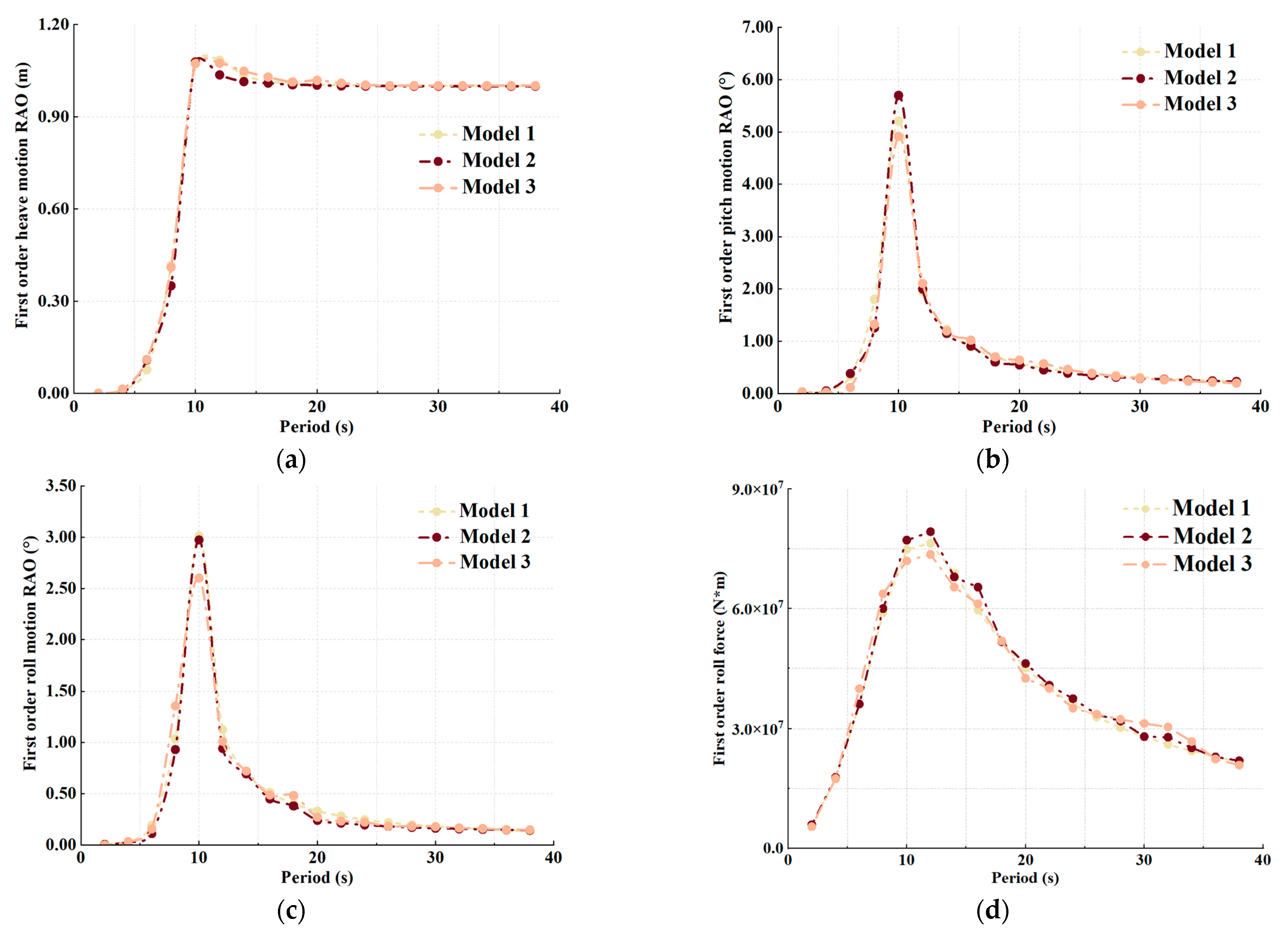
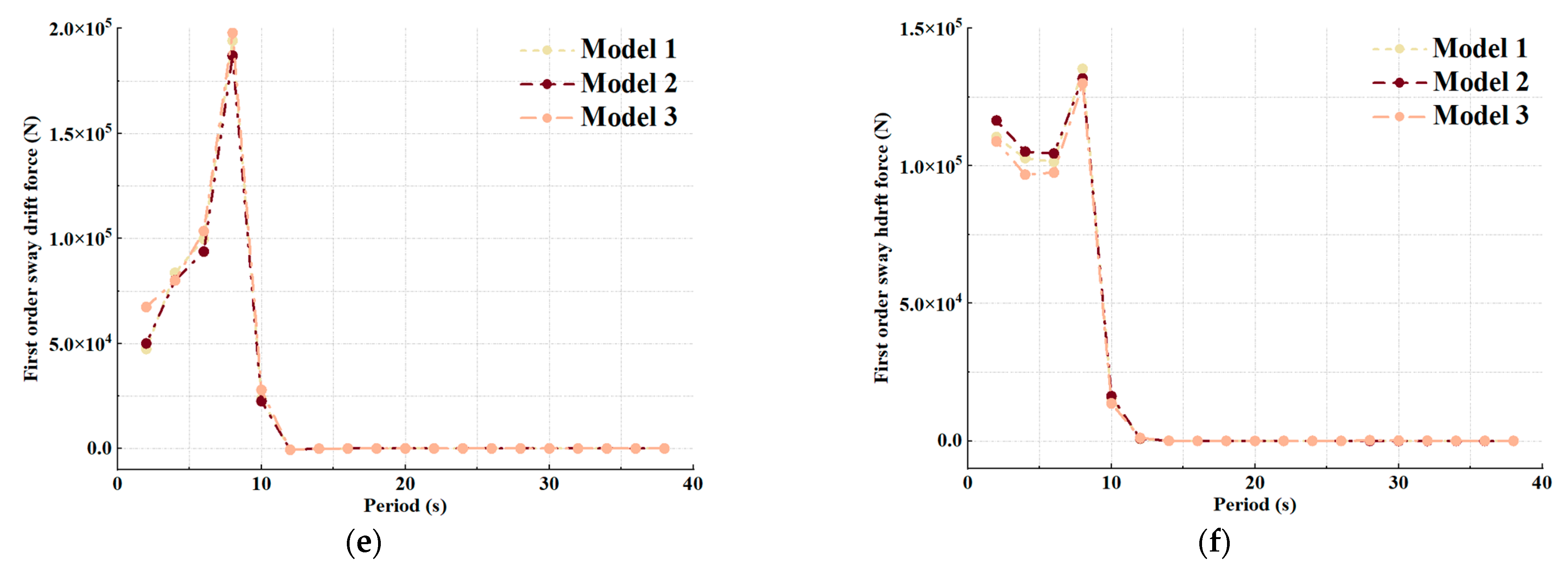

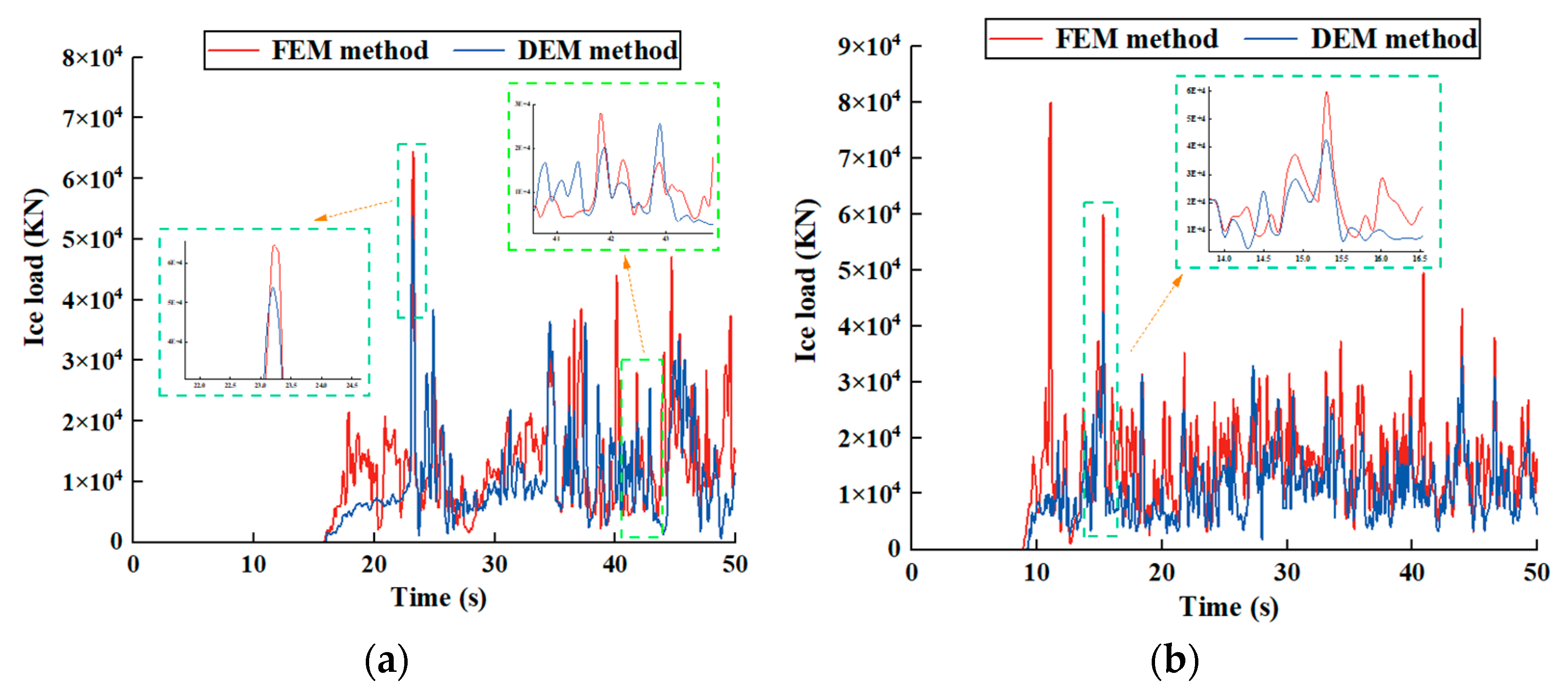
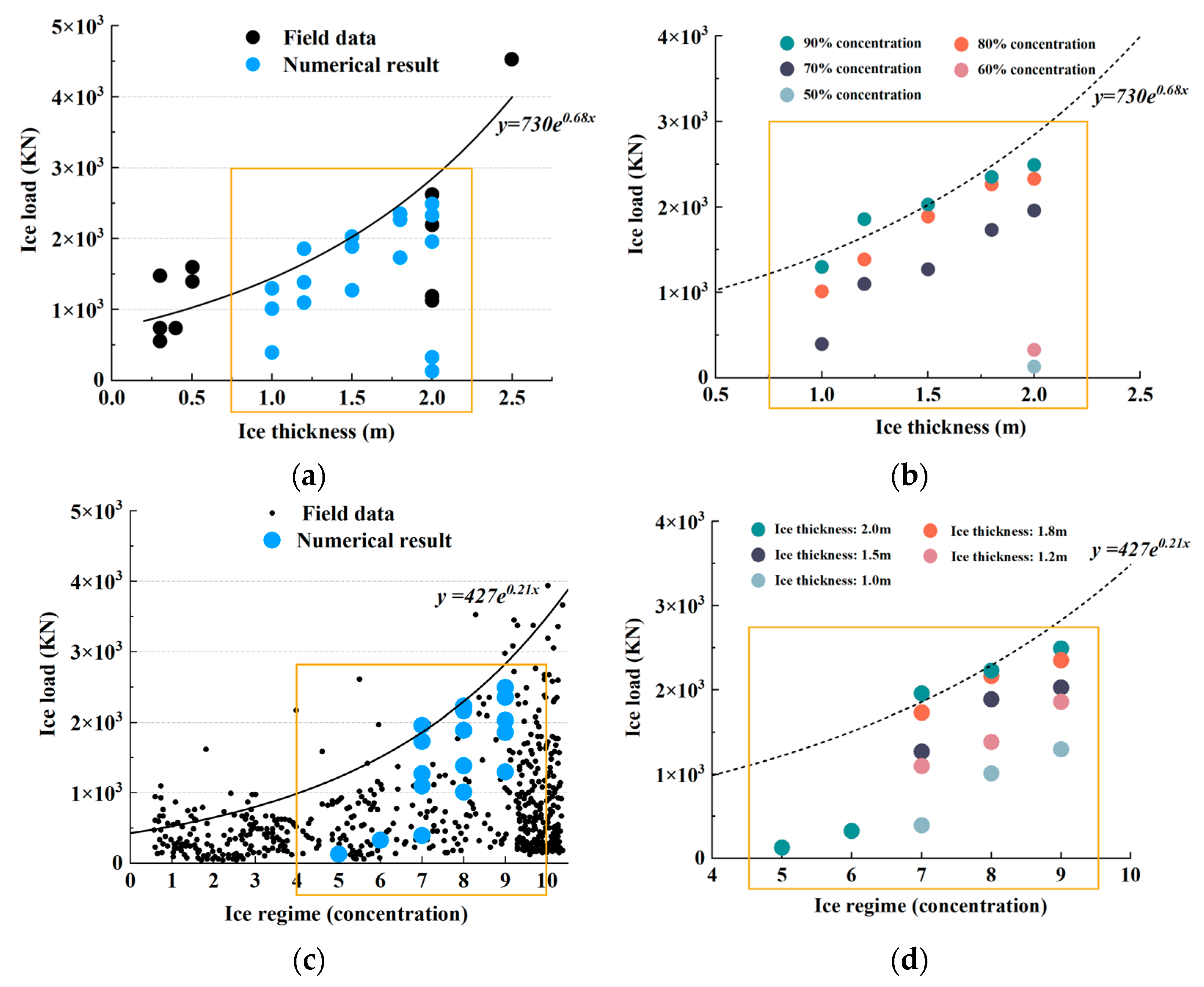


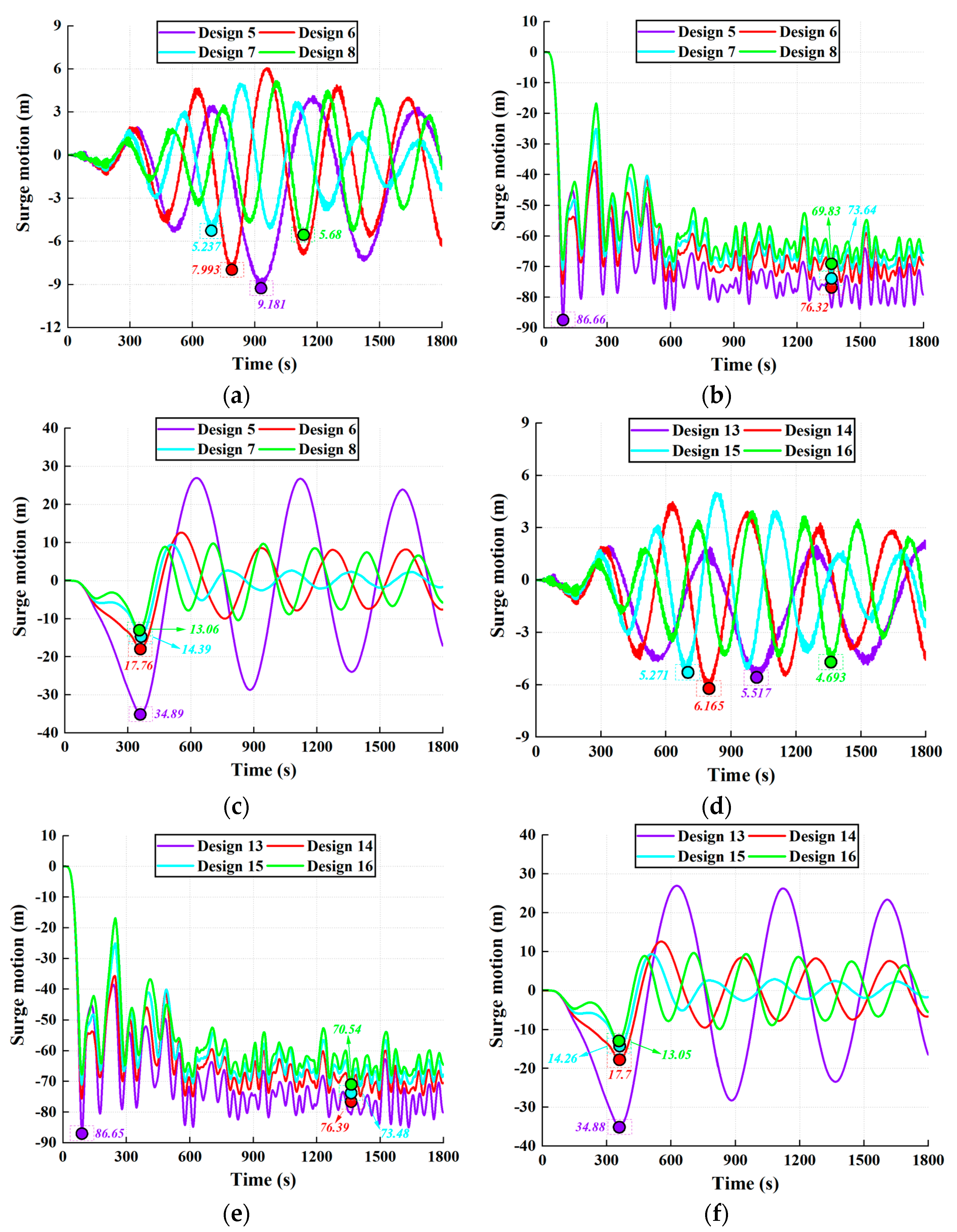
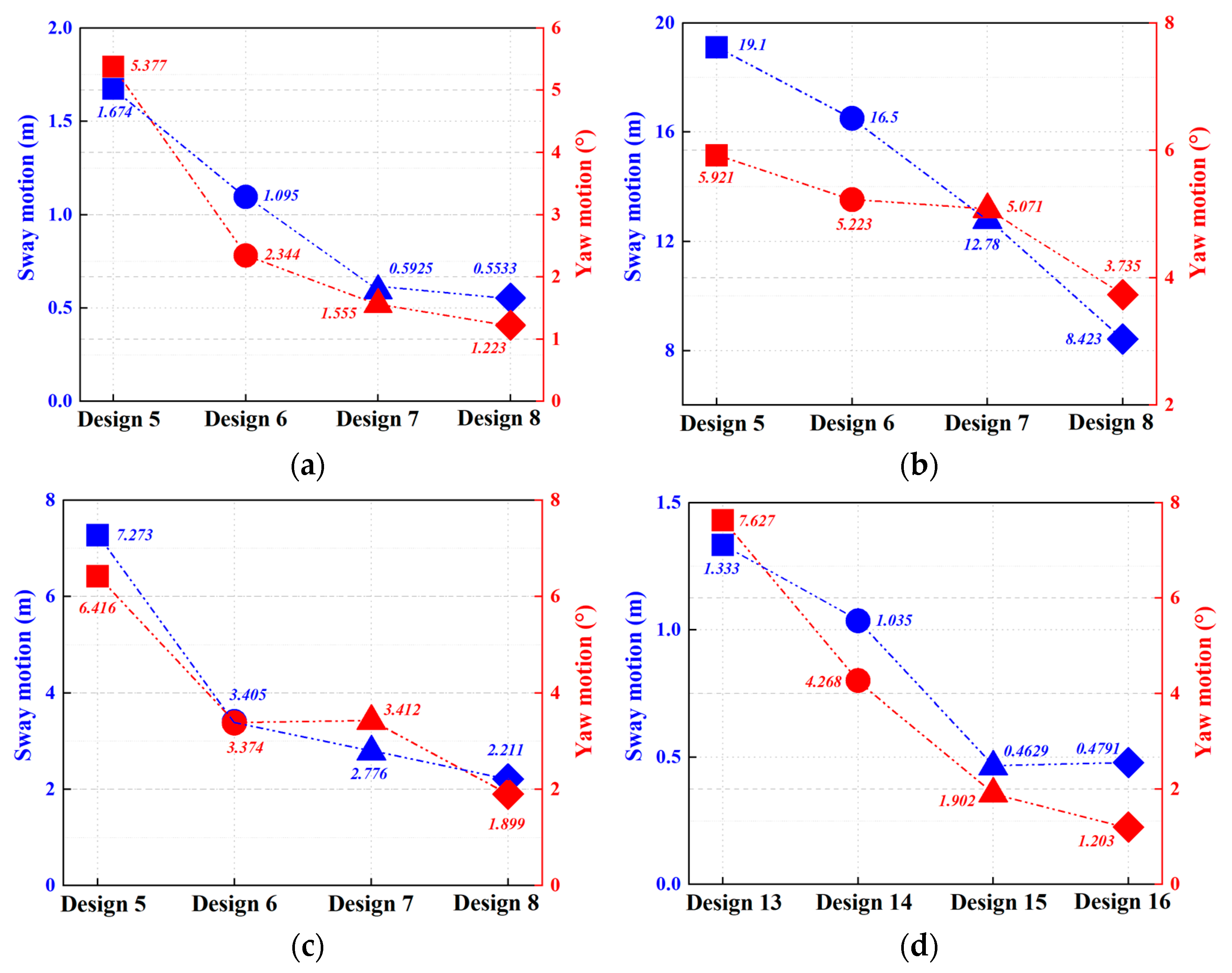
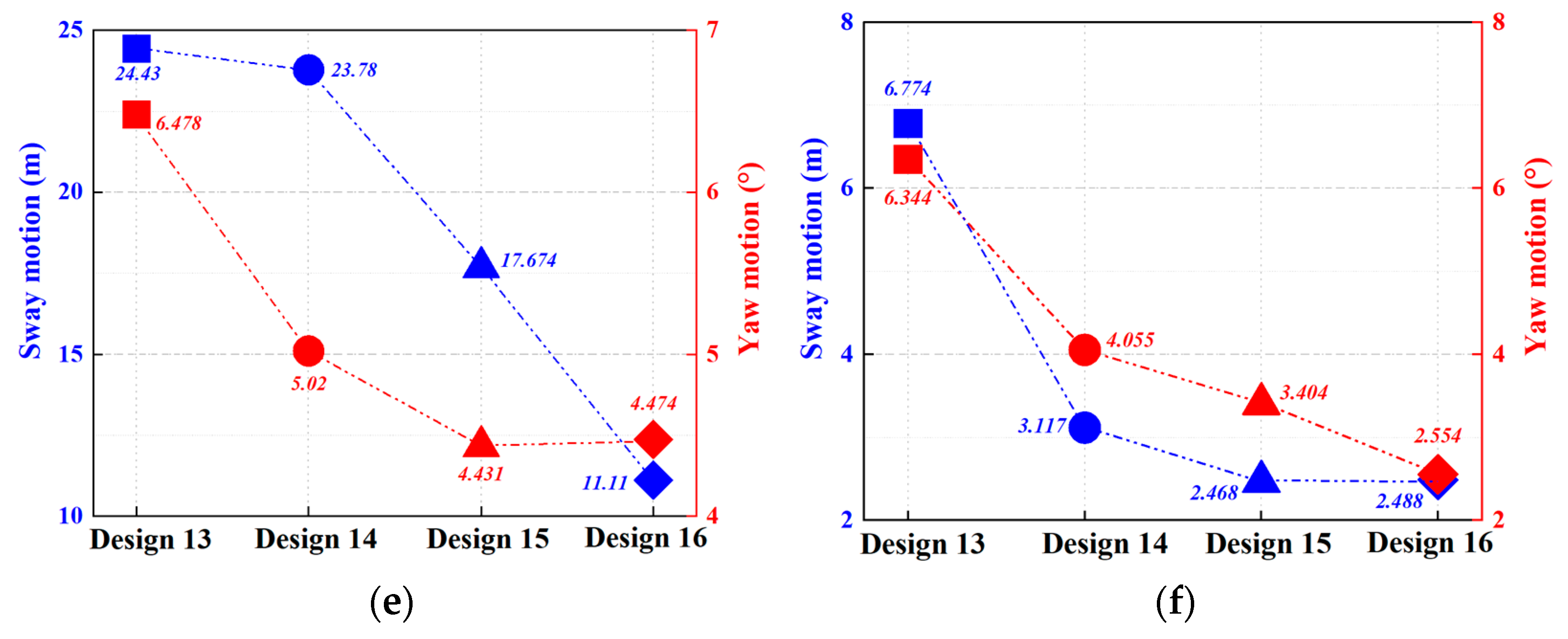

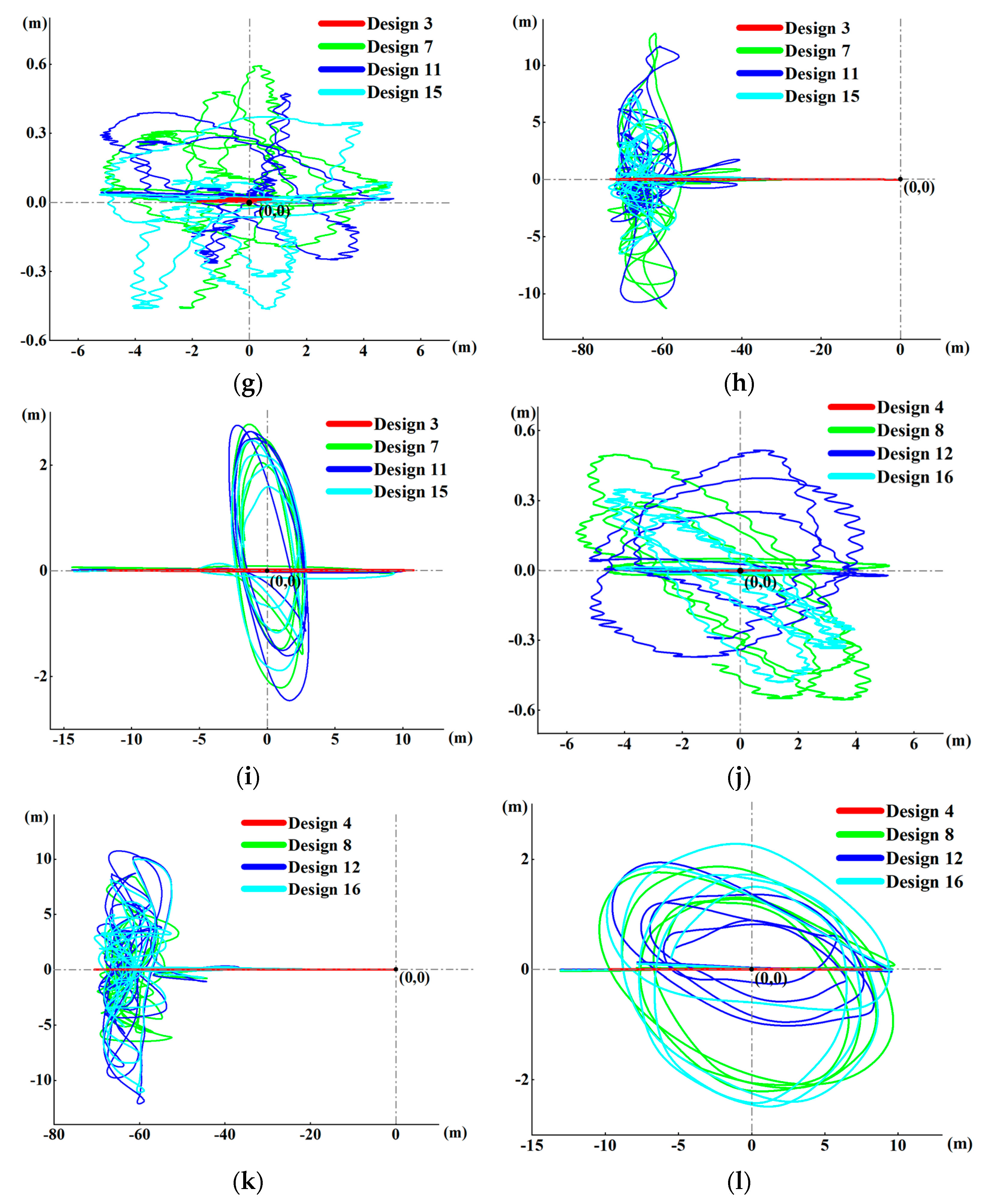
| Parameters | Values |
|---|---|
| Significant wave height (m) | 3.7 |
| Spectral peak period (s) | 6.7 |
| Thickness of the level ice (m) | 1.8 |
| Ice speed (m/s) | 0.1 |
| Thickness of the broken ice floes (m) | 1.8 |
| Average size of the ice floes (m2) | 50 |
| Concentration of the broken ice floes area (%) | 80 |
| Current speed (m/s) | 0.4 |
Disclaimer/Publisher’s Note: The statements, opinions and data contained in all publications are solely those of the individual author(s) and contributor(s) and not of MDPI and/or the editor(s). MDPI and/or the editor(s) disclaim responsibility for any injury to people or property resulting from any ideas, methods, instructions or products referred to in the content. |
© 2023 by the authors. Licensee MDPI, Basel, Switzerland. This article is an open access article distributed under the terms and conditions of the Creative Commons Attribution (CC BY) license (https://creativecommons.org/licenses/by/4.0/).
Share and Cite
Gu, Y.; Chuang, Z.; Zhang, A.; Hu, A.; Ji, S. Dynamic Response Analysis and Positioning Performance Evaluation of an Arctic Floating Platform Based on the Mooring-Assisted Dynamic Positioning System. J. Mar. Sci. Eng. 2023, 11, 486. https://doi.org/10.3390/jmse11030486
Gu Y, Chuang Z, Zhang A, Hu A, Ji S. Dynamic Response Analysis and Positioning Performance Evaluation of an Arctic Floating Platform Based on the Mooring-Assisted Dynamic Positioning System. Journal of Marine Science and Engineering. 2023; 11(3):486. https://doi.org/10.3390/jmse11030486
Chicago/Turabian StyleGu, Yingbin, Zhenju Chuang, Aobo Zhang, Ankang Hu, and Shunying Ji. 2023. "Dynamic Response Analysis and Positioning Performance Evaluation of an Arctic Floating Platform Based on the Mooring-Assisted Dynamic Positioning System" Journal of Marine Science and Engineering 11, no. 3: 486. https://doi.org/10.3390/jmse11030486
APA StyleGu, Y., Chuang, Z., Zhang, A., Hu, A., & Ji, S. (2023). Dynamic Response Analysis and Positioning Performance Evaluation of an Arctic Floating Platform Based on the Mooring-Assisted Dynamic Positioning System. Journal of Marine Science and Engineering, 11(3), 486. https://doi.org/10.3390/jmse11030486







